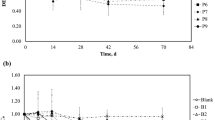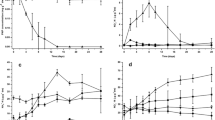Abstract
This work aimed to evaluate the effectiveness of nutrients, H2O2, and tourmaline on the bioremediation of fields where the soil was contaminated with polybrominated diethyl ethers (PBDEs). The results showed that 39.2, 38.3, and 48.1 % of total PBDE removal was observed in microcosms with the addition of nutrients, such as NaNO3, NH4Cl, and NH4NO3, respectively, compared to only 15.2 and 5.8 % of PBDE removal from soil with added Aspergillus niger and control soil, respectively, after 50 days of incubation. In addition, 50.8 and 56.5 % of total PBDE removal were observed in microcosms with 0.5 and 1 μL H2O2. The addition of tourmaline increased total PBDE removal to 32.4 %. Significant increases in soil enzymatic activity with PBDE degraders and bacterial communities were observed using polymerase chain reaction (PCR)—denaturing gradient gel electrophoresis (DGGE). These observations suggested that the combination of inorganic nutrients with chemical, mineral, and biological treatment could improve the PBDE removal efficiency. However, the combination of H2O2 and biological treatment processes is the most efficient technology. This combination of technologies would not cause adverse effects on the subsequent bioremediation process. Therefore, this work offers a potential alternative for the remediation of soil contaminated with PBDE pollutants.







Similar content being viewed by others
References
Alcock RE, Sweetman AJ, Prevedouros K, Jones KC (2003) Understanding levels and trends of BDE-47 in the UK and North America: an assessment of principal reservoirs and source inputs. Environ Int 29:691–698
Andreoni V, Gianfreda L (2007) Bioremediation and monitoring of aromatic-polluted habitats. Appl Microbiol Biotechnol 76:287–308
Caldwell BA (2005) Enzyme activities as a component of soil biodiversity: a review. Pedobiologia 49:637–644
Covaci A, Gheorghe A, Hulea O, Schepens P (2006) Levels and distribution of organochloride pesticides, polychlorinated biphenyls and polybrominated diphenyl ethers in sediments and biodata from the Danube Delta, Romania. Environ Pollut 140:136–149
Eguchi A, Isobe T, Ramu K, Tue NM, Sudaryanto A, Devanathan G, Viet PH, Tana RS, Takahashi S, Subramanian A, Tanabe S (2013) Soil contamination by brominated flame retardants in open waste dumping sites in Asian developing countries. Chemosphere 90:2365–2371
Ferguson SH, Woinarski AZ, Snape I, Morris CE, Revill AT (2004) A field trial of in situ chemical oxidation to remediate long-term diesel contaminated Antarctic soil. Cold Reg Sci Technol 40:47–60
Filip Z (1973) Clay minerals as a factor influencing activity of soil microorganisms. Folia Microbiol 18:56–74
Fiorenza S, Ward CH (1997) Microbial adaptation to hydrogen peroxide and biodegradation of aromatic hydrocarbons. J Ind Microbiol Biotechnol 18:140–151
Frankenberger WT, Dick WA (1983) Relationships between enzyme activities and microbial growth and activity indices in soil. Soil Sci Soc Am J 47:945–951
Hansen LD, Nestler C, Ringelberg D, Bajpai RH (2004) Extended bioremediation of PAH/PCP contaminated soils from the POPILE wood treatment facility. Chemosphere 54:1481–1493
Herwijnen R, Joffe B, Ryngaert A, Hausner M, Springael D, Govers HAJ, Wuertz S, Parson JR (2005) Effect of bioaugmentation and supplementary carbon sources on degradation of polycyclic aromatic hydrocarbons by a soil-derived culture. FEMS Microbiol Ecol 55:122–135
Hites RA, Foran JA, Schwager SJ, Knuth BA, Hamilton MC, Carpenter DO (2004) Global assessment of polybrominated diphenyl ethers in farmed and wild salmon. Environ Sci Technol 38:4945–4949
Hu Y, Yang X (2012) The surface organic modification of tourmaline powder by span-60 and its composite. Appl Surf Sci 258:7540–7545
Huang PM, Bollag JM, Senesi N (2000) Interactions between soil particles and microorganisms. Wiley, New York
Janssen DB, op den Camp HJM, Leenen PJM, Drift CVD (1980) The enzymes of the ammonia assimilation in Pseudomonas aeruginosa. Arch Microbiol 124:197–203
Kim I, Lee M (2012) Pilot scale feasibility study for in-situ chemical oxidation using H2O2 solution conjugated with biodegradation to remediate a diesel contaminated site. J Hazard Mater 241–242:173–181
Kulik N, Goi A, Trapido M, Tuhkanen T (2006) Degradation of polycyclic aromatic hydrocarbons by combined chemical pre-oxidation and bioremediation in creosote contaminated soil. J Environ Manage 78:382–391
Kumar P, Nikakhtari H, Nemati M, Hill GA (2010) Oxidation of phenol in a bioremediation medium using Fenton’s reagent. Environ Technol 31:47–52
Laurent F, Cébron A, Schwartz C, Leyval C (2012) Oxidation of a PAH polluted soil using modified Fenton reaction in unsaturated condition affects biological and physico-chemical properties. Chemosphere 86:659–664
Lee BD, Hosomi M (2001) A hybrid Fenton oxidation–microbial treatment for soil highly contaminated with benz(a)anthracene. Chemosphere 43:1127–1132
Liu G, Jiang N, Zhang L, Liu Z (1996) Soil physical and chemical analysis and description of soil profiles. Standards Press of China, Beijing (In Chinese)
Macnaughton SJ, Stephen JR, Venosa AD, Davis GA, Chang YJ, White DC (1999) Microbial population changes during bioremediation of an experimental oil spill. Appl Environ Microbiol 8:3566–3574
Mills DK, Fitzgerald K, Litchfield CD, Gillevet PM (2003) A comparison of DNA profiling techniques for monitoring nutrient impact on microbial community composition during bioremediation of petroleum-contaminated soils. J Microbiol Methods 54:57–74
Mulder H, Breure AM, Rulkens WH (2001) Application of a mechanistic desorption-biodegradation model to describe the behavior of polycyclic aromatic hydrocarbons in peat soil aggregates. Chemosphere 42:285–299
Nadarajah N, Van Hamme J, Pannu J, Singh A, Ward O (2002) Enhanced transformation of polycyclic aromatic hydrocarbons using a combined Fenton’s reagent, microbial treatment and surfactants. Appl Microbiol Biotechnol 59:540–544
Ni H, Li L, Li H (2008) Tourmaline ceramic balls stimulate growth and metabolism of three fermentation microorganisms. World J Microb Bio 24:725–731
Ni H, Ding C, Lu S, Yin X, Samuel S (2012) Food as a main route of adult exposure to PBDEs in Shenzhen, China. Sci Total Environ 437:10–14
Pelaez AI, Lores I, Sotres A, Mendez-Garcia C, Fernandez-Velarde C, Santos JA, Gallego JLR, Sanchez J (2013) Design and field-scale implementation of an “on site” bioremediation treatment in PAH-polluted soil. Environ Pollut 181:190–199
Romano S, Piazza R, Mugnai C, Giuliani S, Bellucci LG, Huu CN (2013) PBDEs and PCBs in sediments of the Thi Nai Lagoon (Central Vietnam) and soils from its mainland. Chemosphere 90:2396–2402
Romero A, Santos A, Cordero T, Rodríguez-Mirasol J, Rosas JM, Vicente F (2011) Soil remediation by Fenton-like process: phenol removal and soil organic matter modification. Chem Eng J 170:36–43
Sacks VP, Lohmann R (2012) Freely dissolved PBDEs in water and porewater of an urban estuary. Environ Pollut 162:287–293
Sayara TAS (2010) Bioremediation of polycyclic aromatic hydrocarbons (PAHs)-contaminated soil: process evaluation through composting and anaerobic digestion approach. Universitat Autònoma de, Barcelona
Schrader PS, Hess TF (2004) Coupled abiotic-biotic mineralization of 2, 4, 6-trinitrotoluene (TNT) in soil slurry. J Environ Qual 33:1202–1209
Stewart V (1988) Nitrate respiration in relation to facultative metabolism in enterobacteria. Microb Rev 52:190–232
Valderrama C, Alessandri R, Aunola T, Cortina JL, Gamisans X, Tuhkanen T (2009) Oxidation by Fenton’s reagent combined with biological treatment applied to a creosote-comtaminated soil. J Hazard Mater 166:594–602
Voorspoels S, Covaci A, Schepens P (2003) Polybrominated diphenyl ethers in marine species from the Belgian North Sea and the Western Scheldt Estuary: levels, profiles, and distribution. Environ Sci Technol 37:4348–4357
Wang C, Yu L, Zhang Z, Wang B, Sun H (2014) Tourmaline combined with Phanerochaete chrysosporium to remediate agricultural soil contaminated with PAHs and OCPs. J Hazard Mater 264:439–448
Wrenn BA, Sarnecki KL, Kohar ES, Lee K, Venosa AD (2006) Effects of nutrient source and supply on crude oil biodegradation in continuous-flow beach microcosms. J Environ Eng 132:75–84
Xu J, Xin L, Huang TL, Chang K (2011) Enhanced bioremediation of oil contaminated soil by graded modified Fenton oxidation. J Environ Sci 23:1873–1879
Yap CL, Gan S, Ng HK (2010) Application of vegetable oils in the treatment of polycyclic aromatic hydrocarbons-contaminated soils. J Hazard Mater 177:28–41
Zhao D, Liao X, Yan X, Huling S, Chaia T, Tao H (2013) Effect and mechanism of persulfate activated by different methods for PAHs removal in soil. J Hazard Mater 254–255:228–235
Zhou KL (1987) The science of soil enzymes. The Science Press, Beijing (In Chinese)
Acknowledgments
This work was supported by the Ministry of Science and Technology of China (2014CB441104), Tianjin Key Programme of Basic Research (13JCYBJC20200), and National Natural Science Foundation of China (441225014).
Author information
Authors and Affiliations
Corresponding author
Additional information
Responsible editor: Philippe Garrigues
Rights and permissions
About this article
Cite this article
Zhang, Z., Wang, C., Li, J. et al. Enhanced bioremediation of soil from Tianjin, China, contaminated with polybrominated diethyl ethers. Environ Sci Pollut Res 21, 14037–14046 (2014). https://doi.org/10.1007/s11356-014-3313-x
Received:
Accepted:
Published:
Issue Date:
DOI: https://doi.org/10.1007/s11356-014-3313-x




